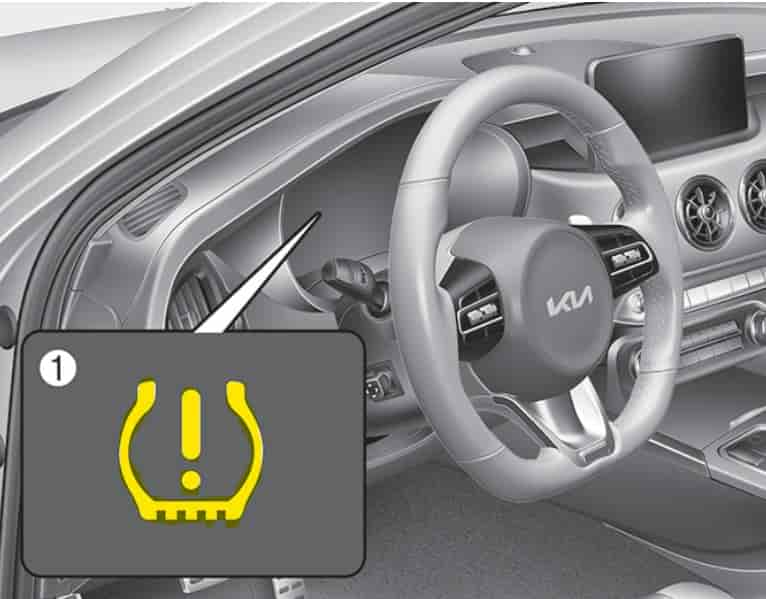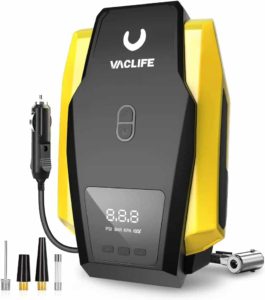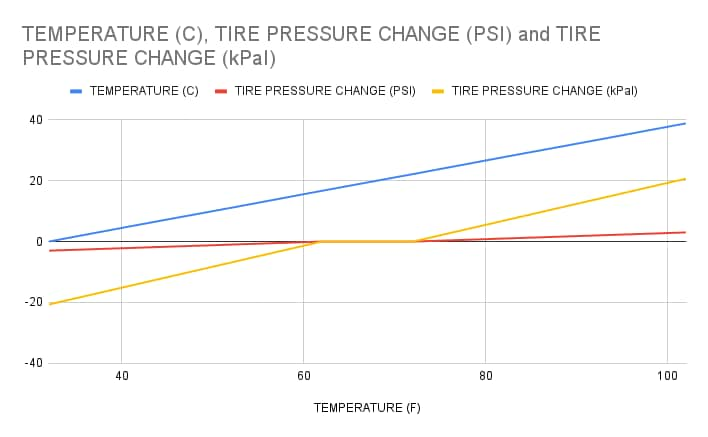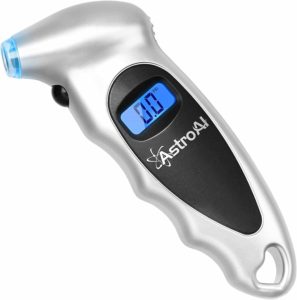The Kia Stinger does not have a magic button to reset the low tire pressure warning light. Don’t worry! Just follow the steps outlined in this article and you’ll be able to turn off your TPMS light without a problem.
What is the Kia Stinger TPMS?
The tire pressure monitoring system (TPMS) in your Kia Stinger is an underrated feature designed to ensure your safety and optimize vehicle performance. It keeps track of the tire pressure levels in your car. This system helps prevent hazardous situations by alerting you through your dashboard warning light if the pressure in one or more tires falls below or rises above the recommended level. When you have 368 horsepower, TPMS is an invaluable tool in maintaining optimal tire health and enhancing your driving experience with the Kia Stinger. To check your current tire pressure: Press the mode button on the steering wheel. Select “information mode” from the LCD display modes.
2023 KIA STINGER TIRE PRESSURE
TIRE SIZE | FRONT PSI | REAR PSI |
225/45R18 | 36 | 39 |
225/40R19 | 36 | 38 |
255/35R19 | 36 | 39 |
SPARE TIRE | 60 | 60 |
Steps to Reset Kia Stinger Tire Pressure Light
The Kia Stinger does not have a tire pressure reset button.
When the tire pressure light on the dashboard lights up, pull over and check your tire pressure right away.
Determine which tire is causing the tire pressure light to turn on and adjust the tire pressure accordingly.
Fill your tire to the exact recommended pressures. I cannot emphasize this enough, accuracy is key. Use the chart above as a reference for your tire sizes.
Drive your Kia Stinger. Drive for a few minutes at speeds over 20 Mph.
If the light doesn’t go off right away, re-check your tire pressure to make sure they are all at the exact pressure you set them to. If they are down in pressure, you probably have some sort of tire leak.
If the pressures are at the exact pressure you set them to and the tire light still won’t go off, over fill your tires.
We recommend filling your problem tire with 46 Psi or about 10 Psi over the recommended pressure. With the tire overfilled, drive the car again for 10 or 15 minutes. This will turn off the tire light.
Now that the tire light is off, readjust the pressure back to the correct pressure levels.
How Does the Kia Stinger TPMS Work?
Sensors: Every tire (excluding the spare) in the Kia Stinger is equipped with a TPMS sensor. This sensor is located inside the tire, attached to the other side of each tire valve. Its primary function is to measure the tire’s pressure level and temperature.
Data Transmission: These sensors transmit the tire pressure data wirelessly to the vehicle’s central control module. The information is sent periodically or when a significant change in tire pressure is detected.
Data Analysis: The central control module and ECU analyzes the data received from each sensor. It compares the pressure level in each tire to Kia’s recommended tire pressure level, which is pre-programed into the system.
Warning Light Activation: If the system detects that the pressure in one or more tires is significantly below or above the recommended level, it triggers a warning light on the vehicle’s dashboard. The light is an exclamation mark inside an outline of a tire and is universally recognized as the TPMS warning symbol.
Immediate Warning for Rapid Deflation: If a rapid loss of tire pressure occurs, like a puncture, the system will immediately trigger the TPMS warning light.
Periodic Checks: The system also performs checks to ensure its functionality on the system itself.
Why is My Tire Light Flashing?
The Kia Stinger also has a separate warning system to let you know when something is wrong with the tire pressure monitoring system (TPMS) itself. It’s called a TPMS malfunction indicator. This warning system uses the same yellow exclamation point, identical to the tire warning light, except it flashes. If there is a problem with the TPMS, the light will flash for approximately one minute then stay on. This will happen every time you start your car until the issue is resolved. So, when your tire light is flashing or blinking, the system will not be able to detect low tire pressure. Basically, a blinking tire pressure light usually means there is a malfunction within the TPMS itself, rather than an air pressure issue. This is likely due to a defective pressure sensor in one of your tires (a dead sensor battery). To determine which sensor is faulty, use a TPMS diagnostic tool.
Why Does the Tire Light Come On?
Seasonal temperature changes: A drop in ambient temperature can cause tire pressure to decrease, triggering the warning light.
Tire puncture or leak: A sharp object or road debris like a nail or screw may puncture a tire, causing air loss which will of course activate the warning light.
Faulty tire pressure sensor: Damaged or malfunctioning sensors may provide inaccurate readings, resulting in a false alert. The only way to determine which sensor is faulty is to scan each sensor with a TPMS diagnostic tool.
Valve stem issues: A damaged or leaking valve stem can lead to gradual pressure loss and eventual activation of the tire pressure light. They make kits to replace the rubber gasket that usually goes bad.
Tire damage: Impact from potholes or hitting a curb can cause structural damage like tire bubbles, leading to pressure loss.
Sensor battery life: TPMS sensors are battery-powered, and over time, batteries die. (they usually last anywhere from 5-10 years) This will cause the tire pressure light to turn on. Again, you must use a diagnostic tool to determine which sensor is dead or dying.
Recent tire rotation or replacement: If the tires have been recently rotated or replaced, the TPMS may need recalibration to avoid false alerts. Sometimes the vehicle’s computer may think the front tires are in the rear and rear in the front after a rotation.
Wheel or rim issues: Damaged, corroded, or cracked wheels or rims can lead to air leaks and pressure loss. This is very common with low profile tires.
Altitude changes: Climbing or descending in elevation can affect tire pressure and trigger the TPMS warning. An additional 1.5 Psi per Km above sea level is required.
Natural pressure loss: Tires lose air pressure over time due to temperature changes and permeation. Tire dry-rot will happen to tires that sit.
Electrical problems or software issues within the car’s TPMS system. Occasionally the system may have a software update from Kia.
Spare Tire: Driving with the spare tire on will set off the tire light
Effects of Underinflated Tires
Decreased Fuel Efficiency: Underinflated tires will cause the Stinger to consume more fuel than it normally would, leading to decreased fuel efficiency.
Poor Handling: Tires that are not properly inflated will negatively affect the car’s handling and responsiveness, which will compromise your control over this beast of a car.
Increased Tire Wear: Underinflated tires tend to wear out quicker and unevenly, as more of the tire’s surface area comes into contact with the road.
Overheating: There is a big risk of tires overheating due to increased friction with the road, which can potentially lead to tire failure.
Effects of Overinflated Tires
Rough Ride: Overinflated tires will make the ride feel bumpy and uncomfortable, as they have less ability to absorb road shocks. The tires feel harder.
Decreased Traction: Overinflated tires have less contact with the road, this reduces traction and makes the vehicle harder to handle, especially in wet conditions.
Increased Wear in the Center: Overinflation causes the middle section of the tire to bulge, resulting in accelerated tread wear in the center of the tire.
Increased Risk of Tire Damage: Overinflated tires are more susceptible to damage from potholes and other road hazards, because they don’t flex like they should.
Does Weather Affect Tire Pressure?
The weather significantly impacts the pressure in your tires. As a general rule, for every 10-degree Fahrenheit drop in temperature, your tires will lose about 1-2 pounds of pressure. This happens because cold air is denser and contracts the tire, which results in lower tire pressure. Conversely, in hot weather the air inside your tires expands, leading to increased tire pressure. It’s important to note that extreme heat can also increase the risk of a blowout if your tires are already overinflated. Therefore, it’s especially crucial to regularly check your tire pressure when there are significant changes in weather conditions.
How to Check Tire Pressure
Get a high-quality tire gauge.
Make sure to check the tire pressure when the tires are cold. “Cold” means your vehicle has been idle for at least three hours or driven less than 1 mile in the past 3 hours.
Take off the valve cap from the tire valve stem.
Push the tire gauge firmly onto the valve to measure the pressure.
Compare the pressure reading with the recommended pressure on the tire information label.
If the pressure is lower than the recommended levels, add air.
If the pressure is too high, let out some air by pressing the metal stem in the center of the tire valve. You can use any object like a screwdriver to do this. Be gentle.
Recheck the tire pressure with the gauge.
Don’t forget to put the valve caps back on to prevent leaks and keep dirt and moisture out.
When Should I Check Tire Pressure?
The best time to check and adjust the tire pressure of your Kia Stinger is in the morning or after your car has been sitting idle for a while. This is because you need your tires to be cool when you’re measuring and changing their pressure. Driving heats up your tires and makes the air inside them expand, which can make the pressure seem higher than it actually is. So, avoid tinkering with your tire pressure right after driving, as it won’t give you an accurate reading and could even create more problems! For the most precise tire pressure reading, it’s important that your car has been sitting for several hours.
Conclusion
In conclusion, maintaining the right tire pressure in your Kia Stinger is not only crucial for your safety, but it also ensures a smoother and more efficient driving experience. By understanding how your vehicle’s tire pressure system works and the effects of incorrect tire pressure, you’re taking a proactive step towards better car maintenance. Regular checks especially with changing weather conditions and before long drives are vital to keep your tires in top shape. Remember, an accurately inflated tire leads to a happier car and a safer drive. So, keep this guide handy and happy driving! Everything in this article is applicable to all Kia Stinger models and trims. Including, Stinger GT-line, and Stinger GT2.
Please note that this blog post contains Amazon affiliate links. This means that if you make a purchase through one of these links, we at TPMSRESET.com may earn a small commission at no extra cost to you. We only recommend products that we personally use and believe in. Thank you for supporting us.





